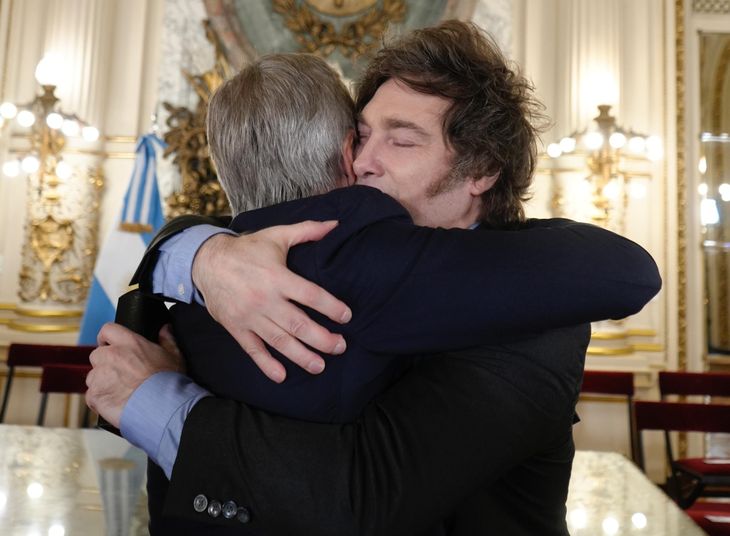In 2000, Fernando’s government De la Rúa, with its Minister of Economy, José Luis Machinea, implemented a “financial armor” plan of more than US $21.5 billion to avoid an economic collapse. It was ensured that capital injection would guarantee stability, restore market confidence and open the doors of sustained growth. However, in just One year, the country entered defaultthe government fell and the worst crisis in modern history whipped the Argentines.
Twenty -five years later, in 2025, Argentina’s economic situation is again on the edge of the abyss. The debt has shot at critical levels, Access to a disbursement of US $ 12,000 million from the IMFaccording to the government has the potential to add up to U $ 23.1 billion. Government measures are announced in the midst of “a cover”: Friday the March inflation that shot at 3.7%, the poverty basket rose 6% And they probably grow in April and May, The same day BCRA dilapidated other US $ 400 million more. The Libra scandal grows: they ask to lift the bank secrecy and locate the presidents Milei and his sister, a “analogy” survey gives very bad the president. The questions are inevitable: was Friday a hot air balloon to distract attention? – Are we in the prelude to an economic collapse?
On November 10, 2000, the Argentine government announced an economic package. However, the strategy presented significant risks, as it now presents them:
IMP DOLARS.JPG
The first IMF disbursement will be US $1,000 million.
Image created with artificial intelligence
Despite the official ads on an imminent agreement with the IMF to guarantee a “2000 financial armor”, the market was still attentive, as will happen as of Monday, April 14. No one is sure of anything.
Coincidences of both shields
Minister José Luis Machinea estimated that the aid package would reach US $21,500 million, Minister Caputo U $ S23.100, although Machinea leaked that the figure could reach au $ 31,000 million and Caputo Au $ 35,000 million. There would be external financing:
- (Machinea) IMF: U $ S14,000 million. (Caputo) U $ S 12,000 million.
- (Machinea) World Bank: U $ S1,000 million. (Caputo) US $ 1,500 million.
- (Machinea) IDB: U $ 2,000 million, Government of Spain: US $ 1 billion, the remaining US $ 13,000 would be internally financed, with US $ 10,000 million from local banks YU $ S3.100 million of the AFJP.
- (Caputo) Repo: U $ S 2 billion dollars and the rest was in a nebula of its makeshift and disattout speech.
The contribution of local banks
(Machinea) Local banks promised to contribute US $ 10,000 million, although US $ 5,000 million corresponded to the renewal of Letes, usually considered automatic. The remaining US $ 5 billion included US $ 3,100 million in public bonds amortization, US $ 1,200 million in interest payments and only US $ 700 million in new placements. In a financial stability scenario with deposits growing at 7% per year, the contribution of the financial system would increase by US $ 4,800 million, minimizing the risk of a credit displacement effect to the private sector.
(Caputo) Local banks have already given everything. With luck they will renew the maturities that will go from pesos to dollars.
Financing and perspective needs
By 2001, Argentina faced financing needs for US $21,900 million (14,000 million in debt amortization, 6,500 million per fiscal deficit and 1,000 million in other concepts). The net financial armor, discounting the renewal of Letes, reached US $ 26,000 million, which in theory was enough to cover all the needs of the year. Milei’s needs in 2026 are extravagant.
The effectiveness of the armor (from the Rúa) depended on access to international markets, just like now (Milei). In case of difficulties, De la Rúa could resort to strategies such as collateralized bonds with world bank guarantees or greater use of external funds, Caputo does not have more rabbits in the galley.
Parallels and “non -parallels” with the current one: the financial indicators of 2025 have critical levels, with a high debt and an economic team with less margin of maneuver than that of 2000.
In December 2000, President Fernando de la Rúa celebrated financial armor as a definitive solution. On Friday, Milei, directly, communicated irrational nonsense, lacking in all truth, made incongruous comparisons, in short … just a year later, on December 20, 2001, of the Rúa resigned in the middle of an unprecedented crisis. In April 2025 we have just attended a 36 -hour strike with high compliance, on Wednesdays the protest of retirees who are usually repressed is routine.
Legend seems to be repeated, but this time, with a more fragile economy and challenges more complex than 2000.
Argentine history has shown us that market confidence is not bought with promises or financial patches. In 2000, Machinea’s armor was celebrated as a shield that would protect the national economy. A year later, the crisis broke out with unprecedented brutality. In 2025, the situation is alarming, the margin of maneuver is closer and International trust was spent all Friday. Can Argentina avoid repeating the same destination or are we facing a fatality?
Milei and Luis Caputo.jpg

Caputo and Milei concluded the agreement with the IMF and the departure of the stocks.
The big mistake of financial armor It was not only his inability to solve the structural problems of the country, but the false sense of security it generated. On Friday Milei and his cast of ministers showed a background photo of the speech that he intended to commercialize equally with the new 2025 armor. The difference is that today the indebtedness is greater, and so far this 2025 we lost 8,200 million reservations. If in 2001 the crisis took many by surprise, in 2025 the story gives us all the warning signals. Ignoring them is risky.
If there is something that the collapse of 2001 taught us is that Magical solutions do not exist. Argentina is again at a crossroads like that of 25 years ago.
Director of Esperanza Foundation. Postgraduate professor at UBA and private universities. Master in International Economic Policy, Doctor of Political Science, author of six books.
Source: Ambito
David William is a talented author who has made a name for himself in the world of writing. He is a professional author who writes on a wide range of topics, from general interest to opinion news. David is currently working as a writer at 24 hours worlds where he brings his unique perspective and in-depth research to his articles, making them both informative and engaging.




